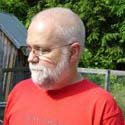Tie me kangaroo down sport,
tie me kangaroo down.
Tie me kangaroo down sport,
tie me kangaroo down. [ . . . ]
Tan me hide when I'm dead, Fred,
tan me hide when I'm dead.
So we tanned his hide when he died Clyde,
[Spoken] And that's it hanging on the shed!
Altogether now!
[© 1960 Castle Music Pty, Ltd.Words and music by Rolf Harris]
Chris, the inside / outside dualism of course predates Descartes, who nevertheless gave it its modern shape; because it is perennial it perennially needs deconstructing. It remains useful (as in the phrase inside the language game of science) as long as it doesn't come to dominate the way we make & understand concepts. I have to admit, though, that I hadn't reaally taken the idea down to its biology, though--hadn't thought except superficially about the skin as the final delimiter between the inner world & the outer. In my existentialist & biologically unsophisticated youth I might have named the skull surrounding the brain as the boarder that cannot be crossed, but that would have been mostly a metaphorical conception anyway. But by citing Taylor, you transform the construction of outer / inner without denaturing it. This is helpful.
I have meditated on this theme topologically. Years ago, riding on the bus between Bellingham & Seattle in Washington State, I was struck by the fact that in order for me to be in the world, my consciousness had by definition to extend out into the world. That is, I realized that consciousness is extensive. On that bus ride I also remembered something I had seen a couple of years before in a museum Edinburgh: a Klien bottle. As you no doubt know, a Klien bottle is a three-dimensional single-sided surface--its outside is its inside. The Klien bottle became my private metaphor for the extensiveness of consciousness.
Philosophical Investigations
Christopher Robinson & Joseph Duemer read Wittgenstein's Philosophical Investigations


0 Comments:
Post a Comment
<< Home